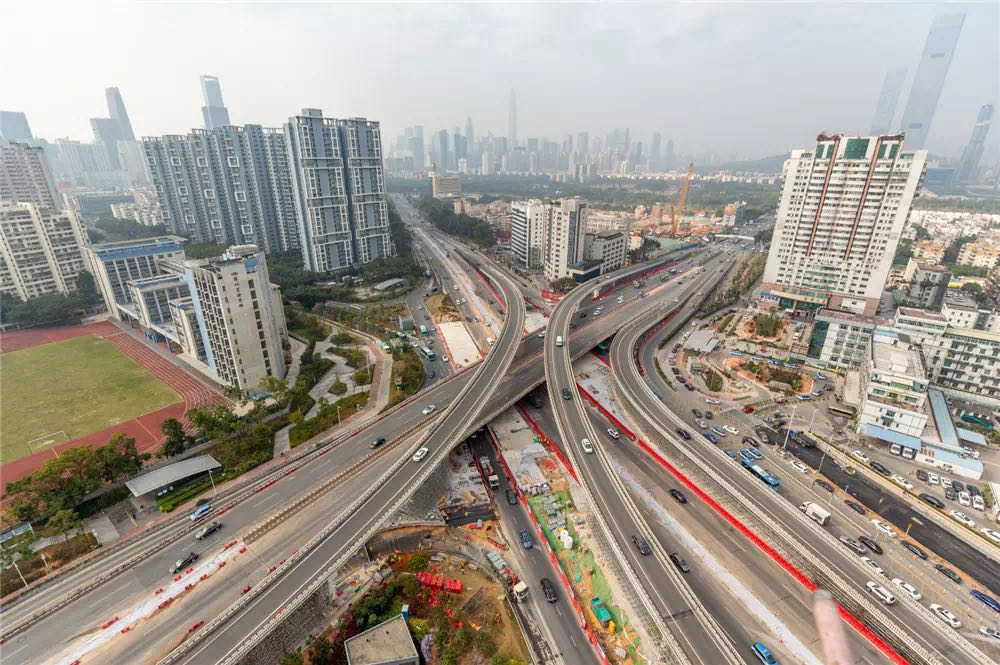Massive flyover dismantled at Shenzhen Speed
Writer: Yang Mei | Editor: Holly Wang | From: | Updated: 2019-02-13

The Huangmugang Flyover before being dismantled. Photos courtesy of the China Railway Tunnel Group (CRTG).
 A picture taken Feb. 3 shows the Huangmugang Flyover has gone.
A picture taken Feb. 3 shows the Huangmugang Flyover has gone.
While thousands upon thousands of Chinese families were getting reunited for the Chinese New Year, 1,500 people from different parts of the country worked around the clock for the demolition of the Huangmugang Flyover in Futian District.
Within nine days they managed to dismantle the complex flyover consisting of five bridges with a total length of 1,544 meters and made of 14,619 cubic meters of concrete, which added a new chapter to the “Shenzhen Speed” legend, according to Wang Lianglei, head of the publicity department of the Huangmugang Project Management Department under the China Railway Tunnel Group (CRTG).
Sha Pingping, head of the Electrical and Mechanical Services Section of the Project Department of CRTG, told the Shenzhen Daily that the construction work started Jan. 29 and was completed Feb. 6, while projects of the same scale would usually take six months. Sha added that although it only took nine days to dismantle the flyover, the success of the project is the result of rigorous and meticulous preparation work that lasted for one and a half months with the participation of 20 or so technicians.
Wang said that before the dismantling officially started, the technicians and professionals used the technology of BIM (Building Information Modeling) to simulate the actual process of the project. BIM is an intelligent 3-D model-based process that gives architecture, engineering, and construction (AEC) professionals the insight and tools to more efficiently plan, design, construct, and manage buildings and infrastructure.
“We set up a modeling on the computer for the simulation, in which every part of the flyover is numbered and the routes for the vehicles at the site are specified so that the cranes will not disturb or collide with one another in time and space, which will guarantee that the actual work goes smoothly and precisely. The professionals carried out four rounds of scenario planning on the table,” Wang said.
Sha told the Shenzhen Daily that a total of 2,340 vehicles and equipment including 30 or so cranes of different tonnage were employed, among them the highlight was the self-propelled modular transporters (SPMTs), or motorized vehicles that move at walking speed and are capable of carrying large structures, such as bridges, from offsite locations, positioning them precisely into their final position.
“We used 240 axles of SPMTs with 16 power pack units (PPUs) and the figure accounts for one-fifth of all the SPMTs in China, which was the first time so many SPMTs had been used in a construction project in China,” Sha said. “The SPMTs can be used to both support the bridges for cutting and to carry and move the concrete to designated areas in a controlled way. Since the flyover was tri-layered and time is limited, the introduction of SPMTs will significantly cut the time and ensure safety compared with the conventional method, which involves a great deal of manual work.”
Yang Hongxi, a manager of SPMT supplier Xi’an Zhengda Multimodal Transport Co. Ltd., based in Xi’an City, Shaanxi Province, said each axle on an SPMT can carry 35 tons of loads.
Wang told the Shenzhen Daily that leaders from the Shenzhen Municipal Government, Shenzhen Metro Group and CRTG paid visits to the construction site and sent greetings to the workers during the Spring Festival holiday. About 100 executives from CRTG also joined the whole team to supervise and guide the workers to ensure safety and quality.
Wang said, “Every day during the project, four meals are delivered to the site for workers and on Chinese New Year’s Eve, we prepared dumplings for them, which really cheered them up.”
Wang said the renovated roads and intersection will be put into service at 12 a.m., Monday or sooner and in the future the area will become a transport hub, integrating Metro lines 7, 14 and 24.